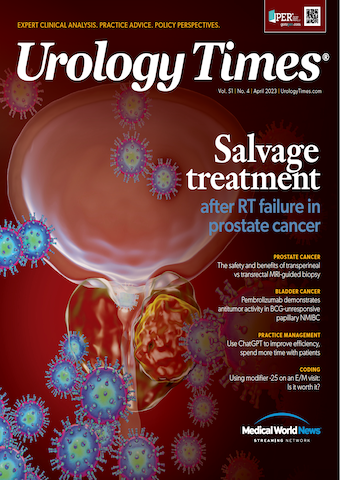Publication
Article
Urology Times Journal
Salvage treatment after RT failure in prostate cancer
Author(s):
Urologists weigh in on the challenges associated with whether, when, and how to treat these patients with prostate cancer.
Radiation therapy eventually fails for between one-fourth and one-third of patients with prostate cancer, leaving urologists, radiation oncologists, and other clinicians to recommend next steps in prostate cancer management.
Urologists say there are challenges to optimally managing these patients, starting with the definition of radiation therapy (RT) failure. Some also say androgen deprivation therapy (ADT) is a common but inadequate salvage option, and there’s a lot that goes into determining which treatment, if any, will achieve optimal results for individual patients.
J. Stephen Jones, MD, questioned the efficacy of external-beam radiation therapy (EBRT) and brachytherapy as a primary treatment for organ-confined prostate cancer, given that at least 25% of patients will have a positive biopsy after the therapy.1
Calculating new prostate cancer cases in the US at the time and using a 25% “conservative” failure rate, Jones wrote, “Radiorecurrent [prostate cancer] is the fourth most common genitourinary malignancy in men, following primary [prostate cancer], bladder cancer, and kidney cancer.”'
Defining RT failure
Jim C. Hu, MD, MPH

There are several reasons why using the currently recommended Phoenix criteria—a prostate-specific antigen (PSA) level rise of 2 ng/mL above the nadir—to define biochemical recurrence of prostate cancer after curative radiotherapy is problematic, according to Jim C. Hu, MD, MPH, professor of urologic oncology at Weill Cornell Medicine, New York, New York.
“We know that the nadir after radiation therapy takes anywhere from 2 to 5 years after radiation. It could take over 5 to 7 years to figure out if [treatment] failed,” Hu said.
The recommendation to give ADT might further obfuscate the PSA level by artificially lowering it, Hu said.
“The challenge…is that, if you fail radiation, you can fail it within the prostate, you can fail outside the prostate, or you can fail both within and outside the prostate. Secondly, that delay in diagnosing a treatment failure could [mean we miss] the window of curability,” Hu said.
Biopsy, staging
Thomas J. Polascik, MD, FACS

Thomas J. Polascik, MD, FACS, professor of surgery and director of the focal therapy program at Duke Prostate and Urological Cancer Center at Duke Cancer Institute, Durham, North Carolina, said in his practice focused on local salvage therapy, local failure is defined as a biopsy-proven, recurrent cancer in the prostate.
Polascik said he also typically biopsies the seminal vesicles to see whether there is failure in the seminal vesicles and where along the length of the gland it is located.
After biopsy and before making therapy recommendations, Polascik said restaging is necessary. “We look at their medical record and history. We look at their PSA levels. We do a physical exam. We look at radiologic scans,” Polascik said. Imaging options have improved in this regard, potentially replacing CT, bone scans, and lymph node dissections, according to Polascik.
“The [prostate-specific membrane antigen (PSMA)] PET CT is a good scan. The CT and the bone scan were not historically good scans. Historically, I used to do lymph node dissections on some of those failures, but the PET scan has gotten to be quite good and I think most people agree that it is a fairly reliable scan to evaluate the lymph nodes after radiation when one suspects failure,” Polascik said.
These tests are important to do because not all failures are considered high risk, according to Neil Fleshner, MD, MPH, FRCSC, professor of surgery and chair of urology at the University of Toronto in Canada.
Risk is based on the Gleason score or International Society of Urological Pathology grade obtained with the biopsy, he said.
“Obviously, the velocity or rate of change of the PSA is extremely important, meaning shorter rises [are] more worrisome. Then, of course, staging, to rule out metastatic progression, is also extremely important,” said Fleshner, who agrees that PSMA PET imaging offers the best possible picture of how prostate cancer might be progressing.
Fleshner advocates strongly for imaging with PET scanning, biopsy, and much more for informed decision-making. There’s a lot at stake, he said.
It’s important to consider a man’s age, comorbidities, and desires, according to Fleshner.
He said he and patients balance those things with a cure rate of salvage therapy, which is not that great; probably in the range of 20% to 25% of patients will have a durable complete response to salvage treatment, Fleshner said.
Many of Fleshner’spatients who do not respond to RT receive expectant management as a result. They watch the disease progression and intervene with hormone therapy if and when needed, which could be years down the road, he said.
“For example, if a patient had a PSA of 2.8 and a biopsy generating not very aggressive disease and that patient still may live 10 or 20 years, there’s no point in rushing into treatment. Most urologists and oncologists will watch this gentleman and maybe treat him when his PSA is around 10, and that could take years,” Fleshner said. “This is the conundrum that the clinician and patient often face.”
Salvage options
Salvage options for these patients include high-intensity focused ultrasound (HIFU), salvage cryoablation, salvage prostatectomy, reirradiating, and/or ADT. Some say ADT isn’t really a salvage therapy because it’s a noncurative option.
Using data from the Cancer of the Prostate Strategic Urological Research Endeavor (CaPSURE) database, Agarwal et al studied the likelihood of treatment failure and outcomes after salvage therapy among men with prostate cancer treated initially with radical prostatectomy or EBRT. Recurrent disease developed in 30% of men, according to the paper, which was published in 2007 in Cancer.2
Recurrent disease developed in 23% (at a mean 34 months) in the radical prostatectomy group and 63% (at a mean 38 months) in the EBRT group. ADT was the most common salvage treatment in both groups, with 59.2% receiving ADT in the radical prostatectomy group compared with 93.5% in the EBRT group.
In the EBRT group, 1.9% received salvage EBRT, 3% cryotherapy, 0.9% salvage radical prostatectomy, and 0.2% brachytherapy.
Sixty-eight percent of men in the radical prostatectomy group and 74% in the EBRT group did not respond to salvage therapy, with no survival benefit in prostate cancer-related death with any combination of primary and salvage therapy, according to the authors.
Today, according to Hu, very few salvage radical prostatectomies, which he does in his practice, are being done. “Given the significant failure rate, I’m not sure what options these men are given,” Hu said. ADT is not curative, and cryotherapy and HIFU are relatively easy with less morbidity, he said. “None of these obviously treat metastatic disease,” Hu said.
Quality-of-life outcomes sought with salvage therapy include preservation of urinary and sexual function, although most will have issues with both after salvage, according to Hu.
“Any salvage therapy after failed radiation will have increased risk of incontinence and [erectile dysfunction],” Hu said.
Urologists’ points of view
Kelly L. Stratton, MD

New imaging options are helping to open the door to local salvage therapies, according to Kelly L. Stratton, MD, associate professor of urologic oncology at Oklahoma University.
“Historically, we would salvage people with prostatectomy or hormonal therapy. Now we’re starting to image people and seeing that they have local recurrences, and then we’re considering maybe we can do additional local therapies, aside from surgery, that would include things like cryotherapy or HIFU,” Stratton said.
Stratton said he tries to avoid ADT in this setting because “that causes a whole litany of [adverse] effects.”
He added, “This creates that middle ground of where the ablative treatments come in, like HIFU and cryo, where we’re not treating systemically, so you wouldn’t have hot flashes, fatigue, or the other effects of [ADT]. We’re also not removing the prostate, so you don’t have the risk of incontinence that you see with radical or salvage prostatectomy.”
Polascik said he instead focuses on local control, saving systemic or hormone therapy for “men who actually need it.” His primary salvage option for patients who are candidates is cryotherapy.
“We have good data, and I have an active practice with cryotherapy,” said Polascik, who recently submitted a paper on real-world outcomes on primary and salvage prostate cancer cryoablation.
In a review of primary focal cryotherapy for prostate cancer, Polascik and coauthors concluded that cryoablation for prostate cancer offers “optimized functional outcomes and a favorable adverse event profile. True evaluation of oncologic outcomes is hampered by lack of long-term follow-up and highly variable clinical end points across these studies. Nonetheless, outcomes appear adequate in the short- to medium-term time frame. Utilization of focal cryoablation is expected to grow with continued refinement of patient selection and management options in cases of treatment failure.”3
Stratton agrees with Polascik on the importance of biopsying the seminal vesicle when considering cryotherapy.
“If the patient has a recurrence in the seminal vesicle after radiation therapy, you probably wouldn’t want to try to use cryotherapy as a salvage treatment,” Stratton said.
HIFU is a newer treatment option for radiation recurrence. There are some nuances to consider, according to Stratton, who said he does a lot of salvage treatment in practice.
“When you think about radiation recurrence, there are people who have had external beam but also people who have had brachytherapy. When you consider HIFU, sometimes the brachytherapy pellets can be obstructive of the energy that you’re trying to deliver to the prostate. So you have to individualize the treatment based on where the cancer is in the prostate, and if there are calcifications or brachytherapy pellets in the way of that treatment,” Stratton said.
The same applies to fiducial markers. “But there are usually only a couple of fiducial markers, so usually you can still HIFU somebody who has fiducial markers. Nonetheless, if there are recurrences adjacent to fiducial markers, you may have to be cognizant of that,” Stratton said.
The different salvage treatments appear to have similar oncologic outcomes, according to Stratton. “In general, recurrence-free survival at 5 years is somewhere in the 50% to 60% range, regardless of what you do—salvage prostatectomy, cryotherapy, HIFU, and even for those studies that looked at reradiation in one form or another,” he said.
Toxicity from salvage treatment includes bowel and urinary toxicity, according to Stratton. “The one thing about the ablative treatment is there is a risk particularly in the radiated patient of a fistula, which can be a devastating complication. So that’s something to consider,” he said.
One of the benefits to patients of doing primary HIFU or cryotherapy ablations is that physicians don’t have to worry about meeting the Phoenix criteria. They can do the biopsies earlier.
“We detect failures earlier and we treat them earlier,” Polascik said.
Practice patterns appear to be shifting in the US, according to Stratton. “Some of the data out of big data like CaPSURE are showing systemic treatment is declining and localized treatment, like salvage cryotherapy or HIFU, is increasing,” he said.
Potentially moving away from ADT is a good thing, according to Stratton. “We want to prevent distant metastasis and certainly prostate cancer mortality, but we also want to maintain quality of life. So there’s a balance there between the risk of cancer progression and the [adverse] effects,” he said.
References
1. Jones JS. Radiorecurrent prostate cancer: an emerging and largely mismanaged epidemic. Eur Urol. 2011;60(3):411-412. doi:10.1016/j.eururo.2011.01.007
2. Agarwal PK, Sadetsky N, Konety BR, Resnick MI, Carroll PR; Cancer of the Prostate Strategic Urological Research Endeavor (CaPSURE). Treatment failure after primary and salvage therapy for prostate cancer: likelihood, patterns of care, and outcomes. Cancer. 2008;112(2):307-314. doi:10.1002/cncr.23161
3. Kotamarti S, Polascik TJ. Focal cryotherapy for prostate cancer: a contemporary literature review. Ann Transl Med. 2023;11(1):26. doi:10.21037/atm-21-5033

































